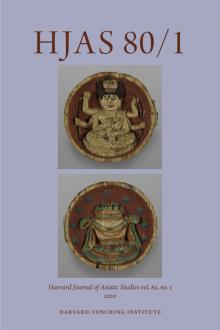June 2020
Small Image of Rãgavidyiarãja (J. Aizen Myōō) in a Circular Shrine, Kamakura ca. 1292. Wood; cinnabar-red pigment applied to the background; bow-and-arrow of thin metal wire; dia. 3.2 cm. Harvard Art Museums/Arthur M. Sackler Museum, Partial and promised gift of Walter C. Sedgwick in memory of Ellery Sedgwick Sr. and Ellery Sedgwick Jr., 2019.122.6. Photo: Imaging Department © President and Fellows of Harvard College.
Editorial Preface
Articles
A Monk for All Seasons
Visions of Jien (1155–1225) in Medieval Japan
Jien’s familial connection to the highest echelons of state bureaucracy ensured his rapid rise and fall within the Tendai Buddhist establishment, illustrating his duality as cleric and worldly politician. Yet the divided portrait of Jien refracted by different academic disciplines obscures Jien’s life and motivations. Using materials written by and about him, I examine Jien’s rise to prominence, his connection to the power centers of his day, his role as a spiritual authority, his investiture of land and positions to his disciples, and his often-ignored role as a prophetic visionary to paint a more holistic picture of his life. I argue that Jien held a consistent spiritually infused worldview most visible during a confrontation with his former sovereign, Retired Emperor Gotoba, on the eve of the Jōkyū War (1221). I argue we can only understand that confrontation by reconciling his political interests and his religious faith.
摘要 :宗教者でもあり政治家でもあった鎌倉時代の僧慈円 (1155–1225) は、政権中枢部 にあった親類の後援により天台座主に就任した。二心を抱いたという批判をしばしば浴 びたが、慈円の生涯と思想の検討をとおして、その信仰と政治思想が一貫したと論じる。
The Memory of an Assassin and Problems of Legitimacy in the Wang Jingwei Regime (1940–1945)
In early 1942, a poetry exchange about a painting on the ancient assassin Jing Ke took place among top collaborators at Nanjing. Chinese cultural memory of Jing Ke, long contested, shifted in the twentieth century, making him into a Republican and national hero, eventually symbolizing resistance against Japan. Thus, these poems, especially considering their Japanese readership, show that although cultural memory can be evoked as a legitimizing discourse to serve political needs, its plasticity gives it versatility. Wang’s own iconography as assassin, central in constructing the legitimacy of his regime, was a floating symbol that assumed varying meanings in different contexts. It simultaneously justified collaboration, assuming that Japan’s pan-Asianism would usher in a new unified Qin empire, and also resistance, assuming Wang Jingwei’s perceived readiness to make a personal sacrifice to save the nation.
本文圍繞 1942 年初南京汪政權的菁英文人間的《易水送別圖》唱酬,通過荊 軻歷史形象的變遷,探討文化記憶的可塑性如何使其在多種語境下獲得多重意義。 它也是一個漂浮的符號,同時肯定抵抗與合作的合法性。
Industry and Its Motivations
Reading Tang Xianzu’s Examination Essay on the Problem of Excess Cloth
Civil-service examination candidates in Ming and Qing China often encountered “small-topic” essay questions, which required them to restrict their analysis to a small fragment of a canonical text rather than a longer, coherent passage. Tang Xianzu’s (1550–1616) “The Woman Would Have Excess Cloth” is one such essay. I argue that this essay goes well beyond the original passage of the Mengzi from which the topic was drawn: it proposes that the ability to exchange one’s excess production on the market is appropriate motivation for an individual to continue to produce. Beginning from the specific case of the woman whose weaving exceeds the needs of her own household, Tang alludes as well to the written work engaged in by literati, framing the sale of cloth and the exchange of letters and prefaces as ethical means of sustaining the motivation on which social discipline is grounded.
明清時期的科舉考生常遇到立意狹窄的 “小題” 題目,迫使他們翻空出奇。 湯顯祖的 “女有餘布” 即為一例。此文超出了孟子原文的本意,展開一種經濟與道德並行的新分析。為避免盈餘對生產動機的負面影響,湯提倡文人、織女均可以售物而介入市場交換,以達致修身齊家的境界。
If Not Philosophy, What Is Xinxue 心學?
I examine the impact of Xinxue (the study of the mind), whose most celebrated teacher was Wang Yangming, not as that of a philosophical or quasi-religious movement, but as a body of editorial practices to be situated among other sixteenth-century textual practices. In the twentieth century, Chuanxi lu (Instructions for practical living) has been read for philosophical content, a category that would have been alien to its sixteenth-century creators. Examining what the editors and compilers of the prefaces and postfaces of Chuanxi lu and Wang Wencheng gong quanshu (Complete works of Wang Yangming) have to say about the construction of these texts, I posit that the content of Xinxue’s teachings—especially, “knowledge and action are one”—cannot be dissociated from the agency of editors in producing these texts.
本文審視明代心學的影響。不將其視為哲學性或類宗教性的運動,本文將其視為十六世紀各種文本編纂活動中的一種編輯實踐。藉由檢視《傳習錄》與 《王文成公全集》編纂者在序跋中所言,我提議:心學的內容,特別是「知行 合一」,不能與編輯們的能動性分離。
